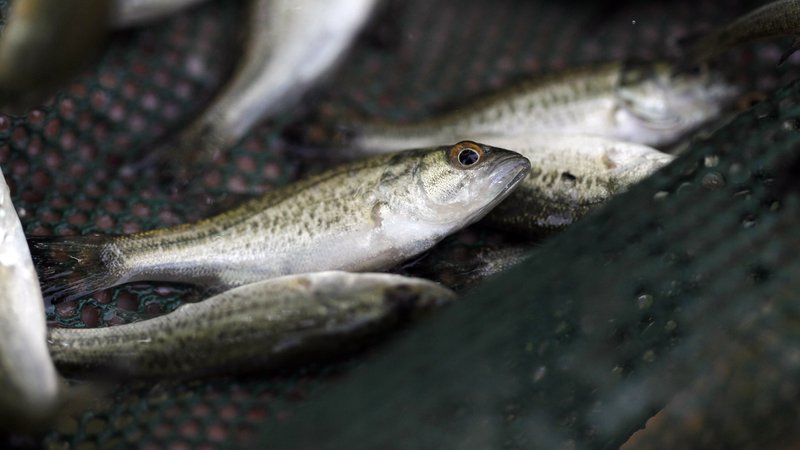Fisheries biologists and staff from the Arkansas Game and Fish Commission’s Andrew Hulsey State Fish Hatchery in Hot Springs recently added a boost to Lake Ouachita’s largemouth bass genetics by stocking more than 150,000 Florida bass fingerlings to the lake in two locations.
Roughly 100,000 Florida bass fingerlings were stocked directly to the Rabbittail area on the lake’s north shore by boats to deposit them in prime nursery cover that will enable the fish to have an increased chance at survival. An additional 52,000 fingerlings were placed in the Lake Ouachita nursery pond for about four weeks to grow and eat a supply of fathead minnows before release into the lake via an underground pipe into the west end of the lake.
Florida bass are a species of black bass that have increased potential to reach trophy sizes. Ultimately, growth rates in both northern largemouths and Florida bass are dependent on the right nutrients, water conditions and growing season length, but Florida bass trend toward a larger size potential given enough time.
This is not the first stocking of Florida bass into Lake Ouachita. According to the current Lake Ouachita Management Plan a pilot study to introduce Florida bass into the lake was initiated in 2007. Fingerlings were stocked at a rate of 100 fingerlings per lake surface acre for eight consecutive years. Evaluations following this pilot study indicated a significant increase in the number of bass with Florida bass genetics, prompting a continuation of the project on an every-other-year basis, alternating Florida stockings between Lake Ouachita, and DeGray Lake in Arkadelphia, which also showed promising results from a similar pilot project.
Sean Lusk, AGFC staff biologist, says the goal of these stockings is not to add more fish to Lake Ouachita, but to increase growth potential by adding Florida bass genetics to the existing population.
“Lake Ouachita produces plenty of bass on its own and these fingerlings will essentially replace some that would have been produced through this year’s spawn,” Lusk said. “Sure, an angler may catch one of these fish if it reaches trophy size, but the real goal is for these fish to reproduce and increase the Florida genetics in the lake.”
During the pilot project, stockings were conducted at Rabbittail and Buckville on the north side of the lake. Once the project was expanded, biologists added the nursery pond at the west end of the lake to provide another point for Florida largemouth introductions.
Rabbittail and the nursery pond received stockings in 2021, and they will again this year.
This is all being done to provide anglers an increased opportunity to someday catch a trophy-size bass.
Brett Hobbs, AGFC regional fisheries supervisor in Hot Springs, said the fingerlings from the pond will see some advantage over those stocked at Rabbittail. Aside from a lack of predators, these bass were able to feed heavily before their addition.
“The nursery pond was stocked with fathead minnows earlier this year,” Hobbs said. “They have been allowed to spawn to provide an abundance of forage for the young bass. The bass fingerlings consumed all the minnows and we opened the pond gate that flows directly into the lake.”
Hobbs says the fingerlings in the nursery pond averaged 3½ inches when released, giving them a jump start on survival.
Visit www.agfc.com/en/fishing/sportfish/black-bassfor more information on bass management in Arkansas. Visit the AGFC Fisheries Division Facebook page at https://www.facebook.com/AGFCFisheriesDivision.







